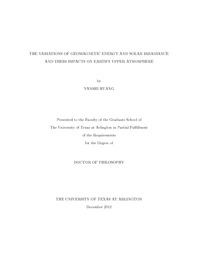
ATTENTION: The works hosted here are being migrated to a new repository that will consolidate resources, improve discoverability, and better show UTA's research impact on the global community. We will update authors as the migration progresses. Please see MavMatrix for more information.
Show simple item record
| dc.contributor.author | Huang, Yanshi | en_US |
| dc.date.accessioned | 2014-03-10T21:03:53Z | |
| dc.date.available | 2014-03-10T21:03:53Z | |
| dc.date.issued | 2014-03-10 | |
| dc.date.submitted | January 2012 | en_US |
| dc.identifier.other | DISS-11889 | en_US |
| dc.identifier.uri | http://hdl.handle.net/10106/24026 | |
| dc.description.abstract | The primary energy sources of Earth's upper atmosphere are the solar irradiance and geomagnetic energy including Joule heating and particle precipitation. Various data and models are utilized to investigate the variations of energy inputs and their influences on the coupled thermosphere-ionosphere system. First, the Flare Irradiance Spectral Model (FISM) has been used and the data show that the solar irradiance enhancement has wavelength dependence during flare events, and it increased largest in the XUV range. NCAR Thermosphere-Ionosphere-Electrodynamics General Circulation Model (TIE-GCM) simulations for the X17.2-class flare event on October 28th, 2003 (X17.2) show that the impact of solar irradiance enhancement on the high-altitude thermosphere (400 km) is largest in the EUV wavebands instead. Secondly, the energy transfer processes into the upper atmosphere associated with high-speed solar wind stream has been investigated. It is a combination of Joule heating and particle precipitation, while Joule heating may play a more important role. We studied the high-latitude forcing from the measurements of DMSP satellite, empirical model Weimer05 and Assimilative mapping of ionospheric electrodynamics (AMIE) model. The yearly average of the northern hemisphere integrated Joule heating (IJH) calculated from AMIE is 85% larger than that from Weimer05. Thirdly, the TIE-GCM model has been used to examine the altitudinal distribution of Joule heating and its influence on the upper atmosphere. The simulation results indicate that most of the Joule heating is deposited under 150 km. For solar minimum, Joule heating above 150 km (18% of total heat) causes about 60% of the total temperature variation and 50% of the total density variation, while for solar maximum, 34% of the total heat is above 150 km and results in 90% of the temperature variation and 80% density variation. This indicates that the high-altitude Joule heating has a stronger impact on the atmosphere at 400 km. At last, the long-term variation of different energy inputs in the last solar cycle has been studied as well. The solar EUV power in last solar minimum (2008) was reduced by 33 GW compared to the previous solar minimum (1996). The reduction of the total geomagnetic energy was close to 29 GW including 13 GW for Joule heating and 16 GW for particle precipitation. The change of the geomagnetic energy from 1996 to 2008 was comparable to that of the solar EUV power. The TIE-GCM simulations indicate that the variation of the solar irradiance and the geomagnetic energy accounts for 3/4 and 1/4 of the total neutral density reduction in 2008, respectively. | en_US |
| dc.description.sponsorship | Deng, Yue | en_US |
| dc.language.iso | en | en_US |
| dc.publisher | Physics | en_US |
| dc.title | The Variations Of Geomagnetic Energy And Solar Irradiance And Their Impacts On Earth's Upper Atmosphere | en_US |
| dc.type | Ph.D. | en_US |
| dc.contributor.committeeChair | Deng, Yue | en_US |
| dc.degree.department | Physics | en_US |
| dc.degree.discipline | Physics | en_US |
| dc.degree.grantor | University of Texas at Arlington | en_US |
| dc.degree.level | doctoral | en_US |
| dc.degree.name | Ph.D. | en_US |
Files in this item
- Name:
- Huang_uta_2502D_11889.pdf
- Size:
- 7.879Mb
- Format:
- PDF
This item appears in the following Collection(s)
Show simple item record


